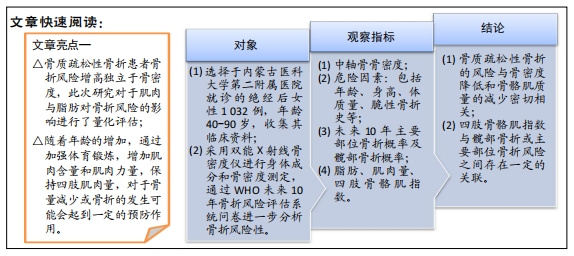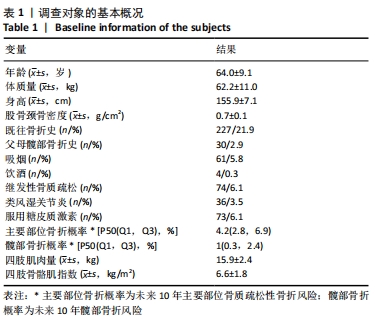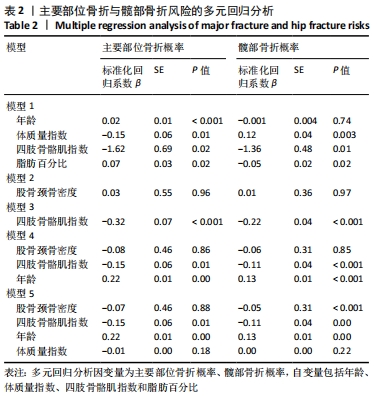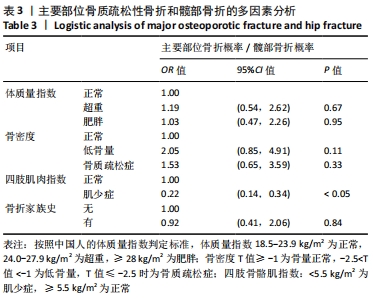[1] GOODMAN CA, HORNBERGER TA, ROBLING AG. Bone and skeletal muscle: Key players in mechanotransduction and potential overlapping mechanisms. Bone. 2015;80:24-36.
[2] KANIS JA, ODEN A, JOHNELL O, et al. The use of clinical risk factors enhances the performance of BMD in the prediction of hip and osteoporotic fractures in men and women. Osteoporos Int. 2007;18(8): 1033-1046.
[3] HARS M, BIVER E, CHEVALLEY T, et al. Low Lean Mass Predicts Incident Fractures Independently From FRAX: a Prospective Cohort Study of Recent Retirees. J Bone Miner Res. 2016;31(11):2048-2056.
[4] KANIS JA, MCCLOSKEY EV, JOHANSSON H, et al. National Osteoporosis Guideline Group. Case finding for the management of osteoporosis with FRAX®—assessment and intervention thresholds for the UK. Osteoporos Int. 2008;19(10):1395-1408.
[5] 冬梅, 金淑霞, 韩杏梅. 呼和浩特地区人群中应用FRAX骨折风险预测工具进行骨折风险评估的临床研究[J]. 中国骨质疏松杂志, 2017,23(8):1067-1070.
[6] KANIS JA, JOHNELL O, ODEN A, et al. Intervention thresholds for osteoporosis in men and women: a study based on data from Sweden. Osteoporos Int. 2005;16(1):6-14.
[7] LASKEY MA. Dual-energy X-ray absorptiometry and body composition. Nutrition. 1996;12(1):45-51.
[8] LEVITT DG, BECKMAN LM, MAGER JR, et al. Comparison of DXA and water measurements of body fat following gastric bypass surgery and a physiological model of body water, fat, and muscle composition. J Appl Physiol (1985). 2010;109(3):786-795.
[9] KIM J, WANG Z, HEYMSFIELD SB, et al. Total-body skeletal muscle mass: estimation by a new dual-energy X-ray absorptiometry method. Am J Clin Nutr. 2002;76(2):378-383.
[10] ZHANG Z, SHEN X, ZHANG H, et al. The relationship between body composition and fracture risk using the FRAX model in central south Chinese postmenopausal women. Clin Endocrinol (Oxf). 2012;77(4): 524-530.
[11] 金淑霞,韩杏梅,武剑,等. 呼和浩特市社区居住中老年人群身体成分分析与骨折风险性的关系[J].中国骨质疏松杂志,2019,25(8): 1150-1153.
[12] 何跃辉, 陈狄, 高谦, 等 . 围绝经期和绝经后女性骨密度的变化及其相关危险因素分析[J]. 中国骨质疏松杂志,2019,25(2):185-188.
[13] HE H, LIU Y, TIAN Q, et al. Relationship of sarcopenia and body composition with osteoporosis. Osteoporos Int. 2016;27(2):473-482.
[14] HARVEY NC, ODÉN A, ORWOLL E, et al. Measures of Physical Performance and Muscle Strength as Predictors of Fracture Risk Independent of FRAX, Falls, and aBMD: A Meta-Analysis of the Osteoporotic Fractures in Men (MrOS) Study. J Bone Miner Res. 2018; 33(12):2150-2157.
[15] MCLEAN RR, KIEL DP, BERRY SD. Lower Lean Mass Measured by Dual-Energy X-ray Absorptiometry (DXA) is Not Associated with Increased Risk of Hip Fracture in Women: The Framingham Osteoporosis Study. Calcif Tissue Int. 2018;103(1):16-23.
[16] LANG T, CAULEY JA, TYLAVSKY F, et al. Computed tomographic measurements of thigh muscle cross-sectional area and attenuation coefficient predict hip fracture: the health, aging, and body composition study. J Bone Miner Res. 2010;25(3):513-519.
[17] 金小岚, 侯建明, 李梅. 肌少症与骨质疏松及骨折[J]. 中华骨质疏松和骨矿盐疾病杂志,2016,9(3):247-250.
[18] 中华医学会骨质疏松和骨矿盐疾病分会. 肌少症共识[J]. 中华骨质疏松和骨矿盐疾病杂志,2016,9(3):215-227.
[19] 金淑霞,郝兴霞,韩杏梅,等. 健康教育对社区居住中老年女性骨折风险性的影响[J]. 世界最新医学信息文摘,2019,19(89):260.
[20] 杜艳萍, 朱汉民. 肌少症的诊疗和防治研究[J]. 中华骨质疏松和骨矿盐疾病杂志,2014,7(1):1-8.
[21] 施慧鹏. 老年人肌肉减少症与脆性骨折[J]. 中华老年医学杂志, 2015,34(11):1167-1169.
[22] 高悠水, 施慧鹏, 李晓林, 等. 老年肌肉减少症与脆性骨折的研究进展[J]. 中华老年骨科与康复电子杂志,2015,1(2):48-52.
[23] HARS M, BIVER E, CHEVALLEY T, et al. Low Lean Mass Predicts Incident Fractures Independently From FRAX: a Prospective Cohort Study of Recent Retirees. J Bone Miner Res. 2016;31(11):2048-2056.
[24] AGUIRRE LE, COLLELUORI G, DORIN R, et al. Hypogonadal Men with Higher Body Mass Index have Higher Bone Density and Better Bone Quality but Reduced Muscle Density. Calcif Tissue Int. 2017;101(6): 602-611.
[25] HARS M, TROMBETTI A. Body composition assessment in the prediction of osteoporotic fractures. Curr Opin Rheumatol. 2017;29(4):394-401.
[26] LESLIE WD, LIX LM, JOHANSSON H, et al. Independent clinical validation of a Canadian FRAX tool: fracture prediction and model calibration. J Bone Miner Res. 2011;25(11):2350-2358.
[27] 贡歌, 万文辉, 王斌, 等. 肌少症对老年股骨颈骨折患者手术疗效的影响[J]. 中华老年医学杂志,2019,38(2):191-195.
[28] IZUORA KE, ALAZRAKI N, BYRD-SELLERS J, et al. Fracture assessment tool risk scores in bone density reports do not change physician prescribing behavior for osteoporosis. Am J Med Sci. 2011;342(1):5-8.
[29] KOUDA K, DONGMEI N, TAMAKI J, et al. Relative Importance of Central and Peripheral Adiposities on Cardiometabolic Variables in Females: A Japanese Population-Based Study. J Clin Densitom. 2017;20:58-65.
[30] TACHIKI T, KOUDA K, DONGMEI N, et al. Muscle strength is associated with bone health independently of muscle mass in postmenopausal women: the Japanese population-based osteoporosis study. J Bone Miner Metab. 2019;37:53-59.
[31] YU R, LEUNG J, WOO J. Sarcopenia combined with FRAX probabilities improves fracture risk prediction in older Chinese men. J Am Med Dir Assoc. 2014;15(12):918-923.
[32] 马剑雄,匡明杰,何伟伟,等. 肌肉减少症与骨质疏松的相关性:研究与应用[J]. 中国组织工程研究,2018,22(32):5222-5227.
[33] 王坤,罗炯,刘立,等.老年人肌少症的成因、评估及应对[J]. 中国组织工程研究,2019,23(11):1767-1773.
[34] 陈兴才, 孔存青, 徐林, 等. 骨质疏松性少肌性肥胖综合征的诊断、治疗及相关影响因素[J]. 中国组织工程研究,2020,24(11):1777-1782.
[35] 许和贵, 李玉雄, 张开伟, 等. 肌肉减少症对绝经后女性脆性骨折的影响[J]. 中国老年学杂志,2018,38(22):5492-5494.
[36] 王永春, 蒲荣喜, 杨忠. 增龄性骨骼肌减少症的细胞及分子机制研究[J]. 中国老年学杂志,2016,36(11):2799-2802.
|





